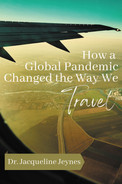The True Impact of a Global Pandemic on Travel and Tourism
At the beginning of 2020, a major coronavirus flu epidemic emerged and made travel to and from China and East Asia almost impossible. As the virus spread globally, at an unprecedented rapid pace, there was a significant, and in many cases devastating, impact on all travel plans, whether for leisure or business, and for tourist destinations all around the world.
People were convinced that it was likely to be a short-term inconvenience and there would soon be a return to 2019 options for travel. No one could foresee how far reaching the pandemic would be or what the long-term impact could be. We have seen that once the first wave of infections and deaths was over, people were optimistic that a new version of normal would be in place by the end of 2020. In particular, plans were being made to travel again in 2021 in pretty much the same way as before the global pandemic took hold.
There had been over 200 million people affected by COVID-19 by August 2021. Between January 2020 and September 2021, we saw sobering statistics concerning the impact of the COVID-19 virus. The speed of infection was rising, taking 10 weeks to go from 30 million to 60 million but only 6 weeks to go from 120 million to 150 million. By the end of 2021, after two years of ups and downs, peaks in numbers of infections or deaths, it was clear that any optimistic thoughts about an end to the pandemic were not realized.
At the same time, just under 50 percent of people surveyed believed that someone close to them would be infected (Wales Government). More people said that it was no longer a case of knowing someone somewhere who may have been infected, but it was definitely getting “closer to home” as new strains such as Omicron took hold and rates of infection rose. Although the new Omicron variant spread rapidly with, apparently, higher infection rates, it did not necessarily result in more severe consequences for those who were infected. The chart in Figure 10.1 gives a striking picture of how extreme this surge was.
Globally there were still differences in rates of infection, hospitalization, and death but it was not always clear why there were such differences. By September 2021, the United States had the highest numbers with 42 million cases recorded and 670,000 deaths. The world’s second highest death toll was in Brazil with 590,000 and Mexico came in fourth at 270,000. These positions change very quickly so it is just a snapshot as Russia and France also saw large numbers of people affected. The most recent statistics can be found on BBC News online Covid map (BBC news/world online).
Figure 10.1 Surge in Omicron cases in 2022
*includes cases reported from international conveyances Source: World Health Organization/Statista.
On the other hand, by the end of 2021, South Africa showed significant reductions in all case numbers though less extreme protective measures seem to have been introduced by the government. Germany had major restrictions and protection measures in place though numbers did not reduce very quickly.
Australia and New Zealand were still operating lockdowns though other countries had eased the restrictions, while in Europe it is believed that the high level of vaccination among the population helped to keep spikes in cases and deaths lower.
As we have seen in earlier discussions, ongoing research with travelers across all age groups during 2020 and 2021 showed that the initial enthusiasm to get back out there and see the world had waned. The picture was now looking bleak.
So, even at the end of 2021, confusion still reigned among the public and governments worldwide. In turn, travel and hospitality sectors were, again, at the forefront of restrictive measures with devastating consequences for an industry already struggling to survive.
In contrast to actions by other governments, the U.K. government removed the majority of the most restrictive protection measures over the 2021 Christmas and New Year period, resulting in the highest levels of infection rates since the first and second waves of the pandemic.
There seemed to be no clear political lead on the best way to deal with the spread apart from reliance on the vaccine and booster programs and the assumption that the “public” could be relied on to act in a sensible way. Clearly not the case as thousands traveled from their own region, where bars and clubs were closed, across to England where they could celebrate with no restrictions! All restrictions were lifted in the United Kingdom in March 2022.
In February 2022, coronavirus statistics were quoted as follows (Statista):
• The United States had seen 78 million cases with 926,029 deaths.
• India had over 42 million cases and 502,905 deaths.
• Brazil had recorded the highest number of cases in Latin America with over 26 million cases and 632,289 deaths.
• France had recorded almost 21 million cases and 132,506 deaths.
• The United Kingdom had nearly 18 million cases and 158,318 deaths, the highest number of deaths in western Europe.
• Italy had over 11 million cases and 148,771 deaths.
Also see Figures 2.2 to 2.4 in Chapter 2.
During 2020, the author was looking closely at strategies for targeting the mature travel sector (JJ). Before the pandemic took hold, hospitality and tourism were the industries showing real growth in a buoyant market. By the time the book was completed at the beginning of 2021, tourism was hardest hit by travel restrictions imposed across the world. As we move out of the pandemic stage into one where we have to live with COVID-19, it is time to agree what the new “normal” will be.

